|
|
|
|
|
|
|
|
|
From 1892, the Board of Trade required that signals in new works must only show red or green lights. This requirement was not mandatory on completely new lines if they were to be used by trains belonging to any railway with a different system of lights. At a meeting of the Railway Clearing House on 27 July 1893, it was recommended that signals should be altered to show only red or green lights.
The straight white stripe used on distant signal arms began to give way to a white chevron, which matched the shape of the fishtail notch [2.64 & 2.65]. This style of signal arm first appeared on the Great Western Railway.
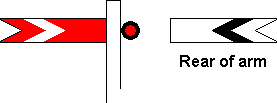 |
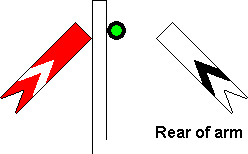 |
|
[2.64] Semaphore Distant Signal ('on').
Area: Various Usage: High Status: Historical |
[2.65] Semaphore Distant Signal ('off').
Area: Various Usage: High Status: Historical |
|---|
While the adoption of the fishtailed arm in distant signals helped drivers to identify them during daylight, it was of no assistance to them at night. Stop signals and distant signals both showed either just a red light when 'on' or a green light when 'off', despite the difference in meaning between the two types of signals. To help distinguish them in darkness, some companies began to fit Coligny-Welch signal lamps to their distant signals from 1898. These displayed a white chevron of light to the right of the coloured lens [2.66 - 2.69], its shape resembling the fishtail notch in the arm. The companies that chose to use these lamps were the LB&SCR, the L&SWR, the SE&CR, and from 1906 the GER, in certain parts of the London area. A few other companies experimented with them on a small scale.
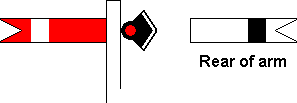 |
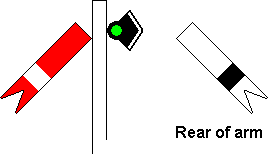 |
|
[2.66] Semaphore Distant Signal with Coligny-Welch Lamp ('on').
Area: Various Usage: High Status: Historical |
[2.67] Semaphore Distant Signal with Coligny-Welch Lamp ('off').
Area: Various Usage: High Status: Historical |
|---|---|
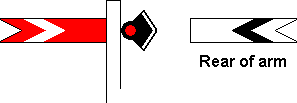 |
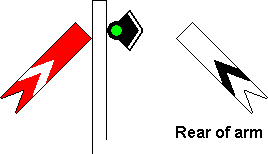 |
|
[2.68] Semaphore Distant Signal with Coligny-Welch Lamp ('on').
Area: Various Usage: High Status: Historical |
[2.69] Semaphore Distant Signal with Coligny-Welch Lamp ('off').
Area: Various Usage: High Status: Historical |
'Enclosed semaphore' or 'banner' signals were used in a few places where clearances were restricted, e.g. at London Victoria (LB&SCR) in 1906/1907. This form of signal comprised a centrally pivoted, electrically operated arm inside a circular frame. When the arm was horizontal [2.70], the signal indicated 'stop', and when inclined at 45° [2.71], it indicated 'clear'. If acting as a distant signal, a fishtail notch was cut into the left-hand end of the arm [2.72 & 2.73]. Of note was the fact that these signals were illuminated during darkness, so they gave the same indications by day or by night.
 |
 |
|
[2.70] Banner Stop Signal ('on').
Area: Various Usage: Medium Status: Historical |
[2.71] Banner Stop Signal ('off').
Area: Various Usage: Medium Status: Historical |
|---|---|
 |
 |
|
[2.72] Banner Distant Signal ('on').
Area: Various Usage: Low Status: Historical |
[2.73] Banner Distant Signal ('off').
Area: Various Usage: Low Status: Historical |
Banner type main signals on the Great Western Railway had a red arm on a black background [2.74 & 2.75].
 |
 |
|
[2.74] Banner Stop Signal ('on').
Area: GWR Usage: Low Status: Historical |
[2.75] Banner Stop Signal ('off').
Area: GWR Usage: Low Status: Historical |
|---|
By c.1909, the Taff Vale Railway was replacing the two white stripes on its distant signal arms (see [2.42 & 2.43]) with two white chevrons [2.76 & 2.77].
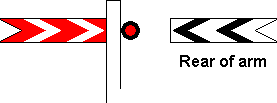 |
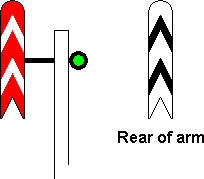 |
|
[2.76] 'Somersault' Distant Signal ('on').
Area: TVR Usage: Medium Status: Historical |
[2.77] 'Somersault' Distant Signal ('off').
Area: TVR Usage: Medium Status: Historical |
|---|
In 1912, the Cheshire Lines Committee installed a precaution signal on the approach to Liverpool Central station, to indicate to drivers whether or not the platform road their train was signalled into was occupied by vehicles. The signal comprised a specially shaped arm [2.78] mounted on the post of the St. James's Down starting signal. A purple light was shown when the arm was in the 'on' position. No light was shown when the arm was cleared [2.79].
 |
 |
|
[2.78] Precaution Signal ('on').
Area: CLC Usage: Low Status: Historical |
[2.79] Precaution Signal ('off').
Area: CLC Usage: Low Status: Historical |
|---|
During 1912, the Swedish company AGA was promoting its flashing acetylene gas signal lamps to various British railway companies. It was thought that they could be used on distant signals to distinguish them from stop signals at night. The GWR experimentally equipped one of its distant signals with a flashing AGA lamp in 1913, but this did not find favour. The lamps proved more of a success on the Furness Railway, where they were fitted to a number of distant signals [2.80 & 2.81].
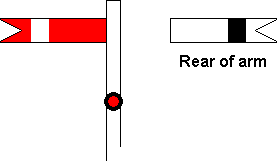 |
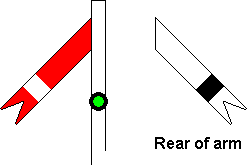 |
|
[2.80] Semaphore Distant Signal with Flashing Lamp ('on').
Area: Fur.R Usage: Medium Status: Historical |
[2.81] Semaphore Distant Signal with Flashing Lamp ('off').
Area: Fur.R Usage: Medium Status: Historical |
|---|
The widespread installation of three-position semaphore signals in North America had generated some interest among the British companies. As described at the beginning of this section, three-position semaphore signals working in the lower quadrant had formerly been used in Britain in conjunction with the time interval system. The new three-position semaphores were motor-operated, and they worked in the upper quadrant to differentiate them from the ordinary two-position semaphores. The arm raised through 45° from horizontal indicated 'caution' [2.82], and through 90° meant 'clear' [2.83]. The 'danger' indication was given when the arm was in the horizontal position, the same as a two-position lower quadrant signal (see [2.9]). The first of these signals was installed by the Great Western Railway in 1914 at London Paddington, and it showed an orange light at night when the arm was in the 'caution' position.
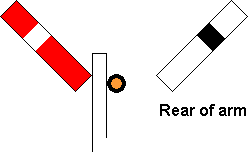 |
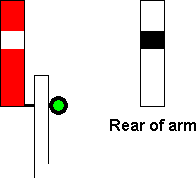 |
|
[2.82] Three-position Semaphore Signal showing 'Caution'.
Area: GWR Usage: Medium Status: Historical |
[2.83] Three-position Semaphore Signal showing 'Clear'.
Area: Various Usage: Medium Status: Historical |
|---|
During the First World War, the Great Eastern Railway painted the fronts of the arms white on some of the semaphore starting signals at London Liverpool Street station.
In May 1916, the Great Central Railway introduced three-position semaphore signals at Keadby Bridge. These signals were similar to the one installed by the GWR at London Paddington, but they showed a yellow light when the arm was in the 'caution' position [2.84], instead of an orange light. These three-position semaphore signals introduced the use of a yellow light for 'caution' into British signalling practice for the first time. Similar three-position semaphore signals were subsequently installed by other companies, at London Victoria (Eastern) (South Eastern & Chatham Railway) in 1920 and at London King's Cross (Great Northern Railway) in 1922.
Although contrary to the Board of Trade's requirement of 1892, the advantage of conveying an unambiguous 'caution' indication by a yellow light was obvious. If applied to two-position semaphore signals, drivers would be able to distinguish, during darkness, a distant signal in the 'on' position from a stop signal without the complication of fitting special types of lamps. In 1916, the Great Central Railway began replacing the red lenses in its two-position distant signals with yellow lenses [2.85].
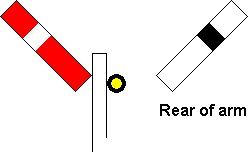 |
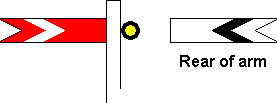 |
|
[2.84] Three-position Semaphore Signal showing 'Caution'.
Area: Various Usage: Medium Status: Historical |
[2.85] Semaphore Distant Signal ('on').
Area: GCR Usage: Unknown Status: Historical |
|---|
When the red lens in a distant signal is altered to yellow, it is logical that the same change of colour be made to the arm. Around 1918, the Great Central Railway fitted yellow arms to some distant signals in the London area [2.86 & 2.87].
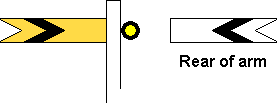 |
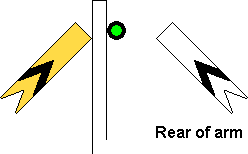 |
|
[2.86] Semaphore Distant Signal with Yellow Arm ('on').
Area: GCR (subsequently All Areas) Usage: High Status: Current |
[2.87] Semaphore Distant Signal with Yellow Arm ('off').
Area: GCR (subsequently All Areas) Usage: High Status: Obsolescent |
|---|
|
|
|